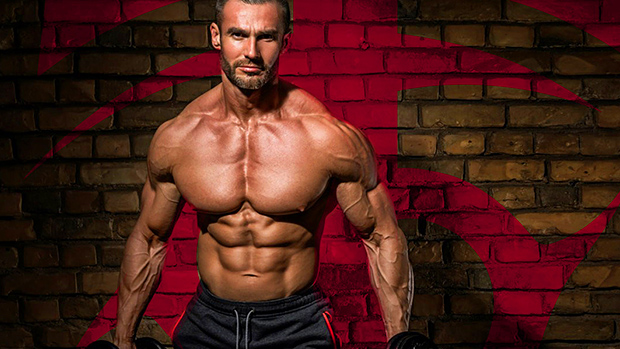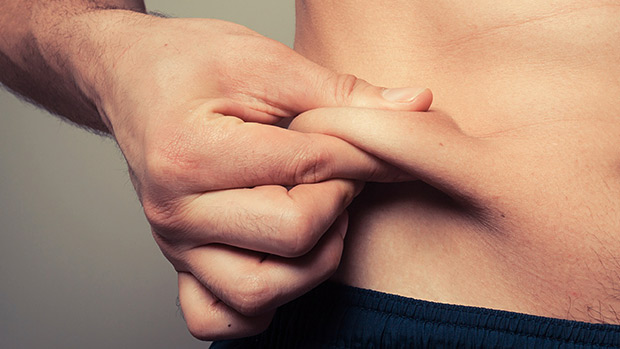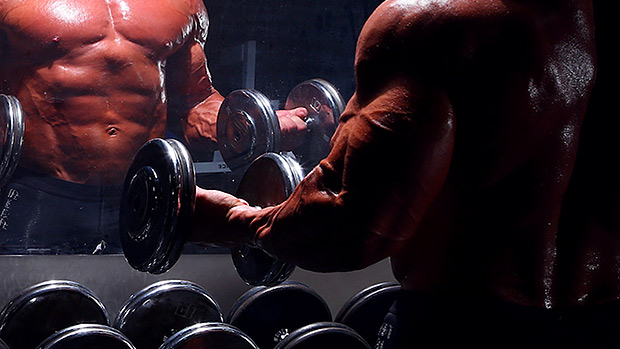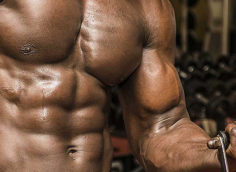I Hate the Words "Cut" and "Bulk"
I really do. But I'll use those words here because not a week goes by that I'm not asked, "Should I cut or bulk?" by some bro after he's laid out his training history, height, weight, eye color, and astrological sign.
As with most things related to training and nutrition, the honest answer is "it depends." It depends on a combination of factors. Let's break them down.
(Note: I'm going to exclude advanced lifters from this one because anyone who's legitimately advanced already knows if he should be in a mass gaining phase or a fat loss phase.)

1. Your Age
This is probably the biggest factor when it comes to being able to bulk or add lean tissue effectively.
Barring some serious physiological disorders, young dudes tend to be bathing in testosterone and growth hormone. They have good insulin sensitivity and they're working with efficient metabolisms. These are the prime years for all-out bulking cycles, and it's when you'll get the most out of them from a growth standpoint.
I'm talking about dudes past puberty and younger than 30. After 30, the loss of fast twitch muscle fibers, the slowing of metabolism, and a shallower and less responsive hormonal pool all become factors for muscle building.
This doesn't mean a noob in his 30's isn't capable of making some awesome muscle mass gains. He can. It just means he's not working with his most optimal physiological environment compared to the late teens and early 20's.
From a nutritional standpoint, your actual age matters significantly. Due to being less insulin sensitive as you age, and needing a greater supply of leucine to maximize muscle protein synthesis, you'll need to manipulate your carbohydrate and protein intake to take these variables into account.
Protein
Lifters under 40, regardless of whether they're bulking or cutting, will get by just fine on a protein intake of 0.8 to 1.0 gram per pound of bodyweight. Someone in their 40's will need a greater intake of protein to fully maximize muscle protein synthesize (while paying special attention to leucine intake).
Over 40 you're going to want to eat protein at a rate of around 1.25 to 1.5 grams per pound of bodyweight, whether you're trying to gain muscle or lose fat.
Carbs
Carb intake should be comparatively different as well. A young guy swimming in hormonal bliss that's relatively lean might need to take in as much as 3.5 grams of carbs per pound of bodyweight in order to maximize growth.
A 45 year old guy who's similarly lean probably won't be able to do that without gaining excessive fat. For a guy in his 40's, carb intake to the tune of 1.5 to 2 grams per pound of bodyweight will be in the ballpark for mass gaining.
Fat
Fat intake during a mass cycle for a younger guy should be on the lower side with carbs being the focus. For the older guy, a slightly higher fat intake, lower carb intake, and high protein intake will serve him best.
Calories
During a smart bulking or cutting cycle, everyone needs to create a starting point at maintenance calories, then adjust protein, carbs, and fats from there. Maintenance for most people is going to fall within the spectrum of bodyweight x 13-15 for caloric intake.
For mass gains, add about 10% to your maintenance intake. Yes, you'll have to log everything, track your weight and body comp, and adjust as needed to fine-tune these starting numbers. That 10% increase in calories comes from carbs, fats, or a combination of both, as long as the requirements for protein are being met.
For a fat loss cycle, simply subtract 10% from maintenance and reduce carbs, fats, or both based on preference. Protein really shouldn't change very much, if at all.

Age and Training
Younger guys with limited training experience will be able to get away with more workouts in a week and still recover. That's mostly because they aren't very strong and haven't cultivated the ability to train with an exceptional amount of effort. Due to their more efficient physiological environment and lack of existential life stress, young dudes can often train more and recover just fine.
But this more or less applies to noobs at any age. If you're still novice to intermediate, you'll probably be able to get away with training more often each week than an advanced guy who's capable of slinging some heavy iron.
- For the young lads, 5-6 training sessions a week will probably be doable.
- With guys over 30, four to five times a week might work best.
- For those over 40, three to four times a week is often ideal.
2. Your Training Experience
As noted, we're dealing with novice and intermediate lifters here. Those tend to be the ones most confused about whether they should bulk or cut.
The longer you've been training, the slower the rate of growth becomes, especially if you've been training with even a modicum of effort. This goes for everyone, regardless of age.
In fact, if you're using a very sound training modality from the start and are consistent with your nutritional approach, you're going to be mostly maxed out on muscle growth by year five. But this doesn't mean you can't eek out a few pounds of muscle after that.
That means a full-force bulking cycle after that first five to seven years isn't going to be anywhere near as result producing as the first five to seven. Keep that in mind.

3. Your Current Body Composition
Ideally, you'd want to start a bulking cycle when you're incredibly lean – single digit body fat. That's ideal because working from an environment with less adipose tissue means less inflammation and usually a better hormonal profile – better nutrient partitioning due to insulin sensitivity and less estrogen (fat cells are highly estrogenic).
Most people don't want to do that in the real world. Guys get a hint of upper abs first thing in the morning, swear they're at 9% body fat, and want to start "packing on the gainz!" Well, gear down there, big rig.
The difference in being lean and being truly peeled is like the difference between whizzing around the local go-kart track and being on the Nuburgring in a Viper ACR. Yeah, you're on a track in both, and technically in a "race car," but it's just not the same.
Since most guys never truly get ripped, they often end up in Skinny-Fat Land. This is where the majority of confusion about whether to bulk or cut comes from. When you're skinny-fat, the scale usually says "runt" but the mirror says "doughnuts."
If you're a total newbie (or have less than a year of really intelligent training experience) and you're more than 18-20% body fat, then you're in luck. No really, you are. Because then you're in that rare period of time where you can lose fat while building a decent amount of muscle at the same time.
Get into a minor caloric deficit and focus on banging out rep PR's on the big lifts.
If you're skinny-fat but in the 12-15% body fat range, then focus on eating a maintenance intake of calories or a very slight surplus, and then bang out the rep PR's.
The common denominator? Getting stronger in the growth-producing rep ranges (8-20), and putting on more muscle. The underlying problem with looking skinny-fat really isn't the degree of body fat. It's the lack of muscle underneath it.
A guy that's 16% body fat who has a lot of quality muscle underneath will look fairly jacked. And that's the difference between him and the guy suffering from skinny-fat disease who weighs 177 who's also 16% body fat. Muscle cures a lot of problems.

4. Your Goals
If your goal is to be as massive as possible at all costs, that's going to circumvent everything else. Throw out age, training experience, and current body comp. If your goal is to be as big as a Buick, then just go, man. Leave no buffet in business and bust every scale you step foot on.
If your goal is to get in shape for a vacation a few months from now, then you have your answer there as well. But you still need to define what being "in shape" for that vacation means.
Defining goals specifically is important. Without having a defined target most people end up in limbo about what to do. That leads them to say stuff like, "I wanna get big and strong... and lose some fat."
That's actually quite atrocious. And I'm not even overstating. What does "get big" mean to you? How big? And in what timeframe?
What does "get strong" mean? When someone tells me they want to get stronger, I don't know what that means. Get stronger at what? The big three? Bodyweight movements? Cartwheels and handstands? A single maximum attempt? A set of twelve reps?
Stop being vague with your goal setting. If you don't set some really specific goals then you'll just drift aimlessly around, not really getting anywhere.
Your goals also need to be realistic. And you need to understand what realism looks like as well.
"I wanna gain 30 pounds of muscle over the summer. I've seen guys do it!"
Okay, MAYBE a noob with amazing outlier genetics who had some intelligent guidance did that, but it's really unlikely. When I hear about these stories I want to shove the storyteller into a Civil War cannon and fire him face-first into a brick wall.
Realistically, 2 to 2.5 pounds of muscle gained per month for the first six months of your training life is going to be ballpark. That's about twelve to fifteen pounds of muscle in the first six months. After that it's going to start slowing down dramatically.
That means if you've been training for more than a year, but less than three, shooting for a bulking goal of five pounds of muscle in the next three months is probably pretty realistic. If you were absolutely perfect in everything you did, five pounds of muscle in three months means that...
- You're lifting more weight for more reps than you ever have before because we're dealing with the need to synthesize new/more muscle proteins. I also said "reps" there. It's not unusual for guys to get maximally stronger in low-rep ranges and not see any new muscle growth.
- You have to figure that even doing your diet perfectly, you'll probably gain muscle to fat at a 1:1 ratio. You have to be in a caloric surplus to gain muscle, so you're going to gain some fat. The key is to limit the fat gain.
- That means you're looking at something to the tune of ten pounds of fat and muscle gain collectively. Factor in the extra water and glycogen that would come with new fat-free mass. Let's up the overall figure to fifteen pounds of overall weight gain. Possibly twenty.
- Your five pounds of new muscle will possibly mean fifteen to twenty pounds of new scale weight if everything is done perfectly.
Getting the picture yet?
Fat loss needs realistic goals and timeframes as well. Not the "I want to lose 15 pounds of fat in the next two weeks" type of bullshit.
Depending on your starting point, one to two pounds of fat loss in a week is probably more realistic. The heavier you are, and the more fat you have to lose, the more fat you can lose initially once you dial into a legitimate energy deficit. The leaner you get, the more difficult it becomes to continue leaning out.
If you've got thirty pounds of fat to lose, which is a lot, then you can expect a timeframe of around sixteen to twenty weeks of real dieting.
As you can see, once you sit down and figure out exact goals and exact timeframes, it will likely dictate your training and diet strategy.
So How Should I Train?
Whatever training you've done that has helped you grow muscle is the same kind of training you're going to want to do for a bulk or a cut. That should make sense, but many lifters change training modalities when they transition from a bulk or a cut... and I'm not sure why.
Whatever training has worked for you in the past is the same training you should do when you're in a hypocaloric state because it will be the kind of training that creates a high degree of muscle retention... with a caveat.
When you're in a caloric surplus, you'll usually see the PR's and have the energy to do more work or include more intensity-increasing methods. When you're in a severe caloric deficit, you won't have the energy for those things.
Trying to do the same amount of work in the gym while in two different incoming energy states isn't very wise. Being super hypocaloric while trying to do a butt-ton of volume is a great way to go catabolic. Especially if you're running low carb and can't offset the increase in cortisol levels from high volume training. Not smart.
This is why it's important to understand that whether you're doing a bulk or cut, it's not about the body part split. It's about growing or retaining muscle through the stimulus you're providing during training, and adjusting your volume so that the demands for recovery can still be met.
- During a cut you'll need to adjust your training volume down to meet the demands for recovery.
- During a mass phase you'll probably be able to get away with more work and still be able to recover.





